
Diaper is any of a wide range of decorative patterns used in a variety of works of art, such as stained glass, heraldic shields, architecture, and silverwork. Its chief use is in the enlivening of plain surfaces.

In heraldry, supporters, sometimes referred to as attendants, are figures or objects usually placed on either side of the shield and depicted holding it up.

In heraldry, a compartment is a design placed under the shield, usually rocks, a grassy mount, or some sort of other landscape upon which the supporters are depicted as standing. Care must be taken to distinguish true compartments from items upon which supporters are merely resting one or more feet, or, sometimes, mere heraldic badges or pure decoration under the shield, and, conversely, care must also be taken in very unusual cases such as the coat of arms of Belize, in which what may be taken to be a crest, the mahogany tree rising above the shield, is really part of the compartment. It is sometimes said to represent the land held by the bearer. As an official part of the blazon it is a comparatively late feature of heraldry, often derived from the need to have different supporters for different families or entities, although sometimes the compartment is treated in the blazon separately from the supporters.

Koog aan de Zaan is a town in the Dutch province of North Holland. It is a part of the municipality of Zaanstad, and lies about 11 km northwest of Amsterdam.
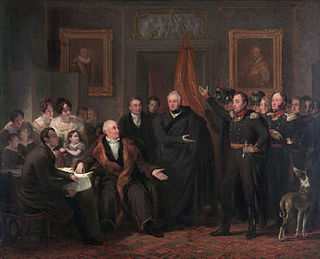
The Dutch nobility is a small elite social class constisting of individuals or families recognized as noble, and with or without a title of nobility in the Kingdom of the Netherlands.

The coat of arms of Amsterdam is the official coat of arms symbol of the city of Amsterdam. It consists of a red shield and a black pale with three silver Saint Andrew's Crosses, the Imperial Crown of Austria, two golden lions, and the motto of Amsterdam. Several heraldic elements have their basis in the history of Amsterdam. The crosses and the crown can be found as decorations on different locations in the city.

The study of Dutch heraldry focuses on the use of coats of arms and other insignia in the country of the Netherlands. Dutch heraldry is characterised by its simple and rather sober style, and in this sense, is closer to its medieval origins than the elaborate styles which developed in other heraldic traditions.
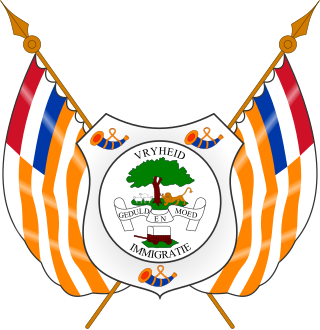
The coat of arms of the Orange Free State was the official heraldic symbol of the Orange Free State as a republic from 1857 to 1902, and later, from 1937 to 1994, as a province of South Africa. It is now obsolete.

The coat of arms of Rotterdam is the official symbol of the city of Rotterdam. It consists of a shield and has a green band of the original weapon of Weena, bisected by a white band symbolizes the Rotte, two golden lions, and four lions, two black and two red on a gold field, and the motto of Rotterdam.

The coat of arms of Sint Eustatius consists of a shield and the motto. It was established on 9 November 2004 by the Island council of Sint Eustatius, when it was still part of the Netherlands Antilles. It remained the coat of arms of Sint Eustatius after the dissolution of the Netherlands Antilles and the subsequent change of Sint Eustatius's constitutional status into a special municipality of the Netherlands in 2010.
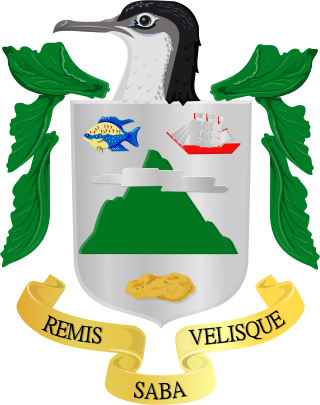
The coat of arms of Saba was established in 1985 by the island council of Saba, when it was still part of the Netherlands Antilles. It remained the coat of arms of Saba after the dissolution of the Netherlands Antilles, and the subsequent change of Saba's constitutional status into a special municipality of the Netherlands in 2010.

The coat of arms of Bonaire was established in 1986 by the island council, when Bonaire was still part of the Netherlands Antilles. It remained the coat of arms of Bonaire after the dissolution of the Netherlands Antilles and the subsequent change of Bonaire's constitutional status into a special municipality of the Netherlands in 2010.

The coat of arms of Hoorn is a coat of arms that has been in use since the middle ages. Although over time it underwent some changes, there has been no change to the coat of arms since it was acknowledged in use by the High Council of Nobility in 1816. At present, in the original form, it is the coat of arms of the municipality of Hoorn. The current municipality was formed in 1979 by merging the city of Hoorn with the villages Zwaag and Westerblokker; it was decided to use the old coat of arms as coat of arms of the new municipality.

The coat of arms of Beverwijk is a coat of arms that has been renewed several times. The coat of arms of Beverwijk is the only coat of arms of a Dutch municipality that is surrounded by a cloak. This is highly unusual in the Netherlands, where such a cloak is normally reserved for nobility, the pope and national coats of arms.

The coat of arms of Groningen is an official symbol of the province. It was designed when the region was united in 1595 and formally approved in 1947 by Queen Wilhelmina. The coat of arms consists of two lions supporting a crowned shield which is decorated with the shields of the city of Groningen and of the Ommelanden.

The coat of arms of Enkhuizen has been the coat of arms ever since Enkhuizen received borough rights in 1355. The coat of arms was acknowledged in 1816 by the High Council of Nobility, the coat of arms has not been changed ever since.
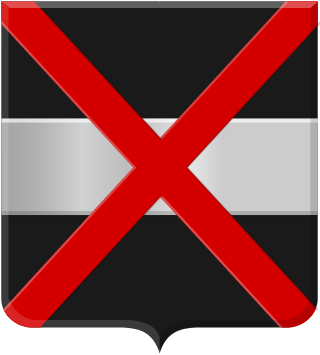
The Lordship of Baarsdorp is a (former) Dutch Lordship situated in the province of Zeeland, in the Netherlands.
This page shows the coats of arms, heraldic achievements, and heraldic flags of the House of Nassau.
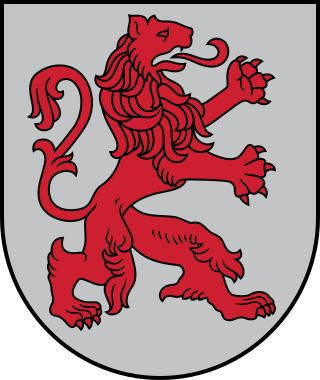
The coat of arms of Courland (Kurzeme), a historical region in western Latvia, has been known since the 16th century and depicts a lion gules on a silver background.

The coat of arms of the municipality and town of Weert in Limburg in the Netherlands was assigned to the municipality on 16 November 1977 by royal decree by the High Council of Nobility. It replaced the first coat of arms from 1918.




















